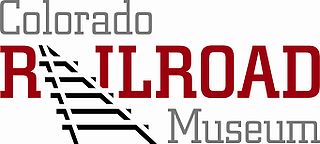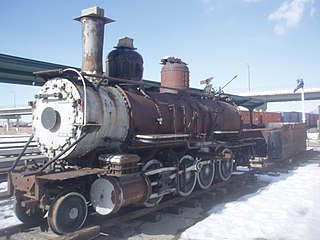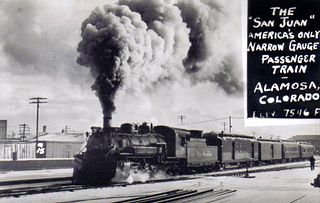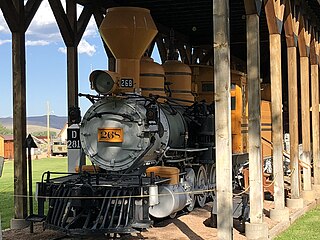Related Research Articles

The Denver and Rio Grande Western Railroad, often shortened to Rio Grande, D&RG or D&RGW, formerly the Denver & Rio Grande Railroad, was an American Class I railroad company. The railroad started as a 3 ft narrow-gauge line running south from Denver, Colorado, in 1870. It served mainly as a transcontinental bridge line between Denver and Ogden, Utah. The Rio Grande was also a major origin of coal and mineral traffic.

The SD40T-2 is a model of diesel-electric locomotive built by General Motors Electro-Motive Division in the United States. The SD40T-2 is equipped with a 16-cylinder EMD 645E3 diesel engine producing 3,000 horsepower (2,240 kW). 312 SD40T-2s were built for three railroads in the United States between April 1974 and July 1980. This locomotive and the SD45T-2 are popularly called tunnel motors, but EMD's term is SD40-2 with "cooling system modifications" because they were designed for better engine cooling in mountainous areas. The difference between this locomotive and its non-tunnel motor cousin, the SD40-2, are the radiator air intakes are located lower down at the rear of the locomotive.

The Cumbres and Toltec Scenic Railroad, often abbreviated as the C&TSRR, is a 3 ft narrow-gauge heritage railroad that operates on 64 miles (103 km) of track between Antonito, Colorado, and Chama, New Mexico, in the United States. The railroad is named for two geographical features along the route: the 10,015-foot (3,053 m)-high Cumbres Pass and the Toltec Gorge. Originally part of the Denver and Rio Grande Western Railroad's narrow-gauge network, the line has been jointly owned by the states of Colorado and New Mexico since 1970.

The Durango and Silverton Narrow Gauge Railroad, often abbreviated as the D&SNG, is a 3 ft (914 mm) narrow-gauge heritage railroad that operates on 45.2 miles (72.7 km) of track between Durango and Silverton, in the U.S. state of Colorado. The railway is a federally-designated National Historic Landmark and was also designated by the American Society of Civil Engineers as a National Historic Civil Engineering Landmark in 1968.

The Heber Valley Railroad (HVRX) is a heritage railroad based in Heber City, Utah. It operates passenger excursion trains along a line between Heber City and Vivian Park, which is located in Provo Canyon. The HVRX carries over 110,000 passengers a year.

The Colorado Railroad Museum is a non-profit railroad museum. The museum is located on 15 acres (6.1 ha) at a point where Clear Creek flows between North and South Table Mountains in Golden, Colorado.

The Ghost Town & Calico Railway is a 3 ft narrow-gauge heritage railroad and amusement park attraction within Knott's Berry Farm, an amusement park located in Buena Park, California.

The Rio Grande Zephyr was a passenger train operated by Denver and Rio Grande Western Railroad between Denver, Colorado and Ogden, Utah from 1970 until 1983. In operation after the creation of publicly-funded Amtrak, the Rio Grande Zephyr was the last privately-operated interstate passenger train in the United States.

The D&RG Narrow Gauge Trestle, also known as the Cimarron Canyon trestle, is a narrow-gauge railroad deck truss bridge crossing the Cimarron River near Cimarron, Colorado. Located within the Curecanti National Recreation Area, the trestle is the last remaining railroad bridge along the Denver & Rio Grande Railroad's Black Canyon route, a narrow-gauge passenger and freight line that traversed the famous Black Canyon of the Gunnison between 1882 and the 1940s.

The Denver and Rio Grande Western K-27 is a class of 3 ft narrow gauge 2-8-2 "Mikado" type steam locomotives built for the Denver and Rio Grande Railroad by the Baldwin Locomotive Works in 1903. Known by their nickname "Mudhens," they were the first and the most numerous of the four K classes of Rio Grande narrow gauge engines to be built. Two of the original fleet of 15 locomotives were preserved and operate on heritage railways in the United States. No. 463 is operational on the Cumbres and Toltec Scenic Railroad (C&TSRR) in Chama, New Mexico and No. 464 is currently out of service due to a rebuild on the Huckleberry Railroad in Genesee Township, Michigan.

The Monarch Branch was a branch line of the Denver & Rio Grande Western built in the 1880s to serve the Colorado Fuel & Iron limestone quarry at Monarch, Colorado. Originally part of the D&RGW's 3 ft 0 in narrow-gauge system, the 15 mile line connected with the rest of the narrow-gauge network at Poncha Junction, on the Marshall Pass line. The upper part of the Branch was on a 4.5% grade and included both an "S" curve and a double switchback to reach an elevation of over 10,000 ft. The line was converted to standard-gauge in 1956 after the narrow-gauge mainline from Salida to Gunnison was closed in the early 1950s. From that time forward, the line operated as a standard-gauge branch of the D&RGW until the early 1980s when Colorado Fuel & Iron closed its blast furnaces at Pueblo, Colorado. Operations on the Monarch Branch subsequently ceased and the rails were pulled up a short time later.

The Denver and Rio Grande Western K-37 is a class of 2-8-2 "Mikado" type narrow-gauge steam locomotives built for the Denver and Rio Grande Western Railroad. They were new steam locomotives built in the D&RGW Burnham Shops as a near copy of the Rio Grande class K-36. In-house production was chosen to preemptively address material shortages and personnel issues. Burnham Shops was assisted in the construction of the class by the Stearn-Rogers Manufacturing Company. The class recycled components from Baldwin Locomotive Works-built Class 19 2-8-0 locomotives used on the Rio Grande's standard gauge; re-using the boiler, tender and other components salvaged from the C-41's. The engine components were constructed new for the locomotive class.

Denver and Rio Grande Western No. 169 is a 4-6-0 "Ten Wheeler" type narrow gauge steam locomotive. It is one of twelve similar locomotives built for the Denver and Rio Grande Railroad (D&RGW) by Baldwin Locomotive Works in 1883. It was built as a passenger locomotive, with 46 in (1,200 mm) drivers, the second largest drivers used on any three-foot gauge D&RGW locomotive.

Denver and Rio Grande Western No. 168 is a class "T-12" 4-6-0 “Ten Wheeler” type narrow-gauge steam locomotive. It is one of twelve similar locomotives built for the Denver and Rio Grande Railroad (D&RG) by the Baldwin Locomotive Works in 1883. It was built as a passenger locomotive, with 46 in (1,200 mm) drivers, the largest drivers used on any three-foot gauge D&RGW locomotive. The large drivers made it suitable for relatively fast passenger service.

Denver and Rio Grande Western 223 is a 2-8-0 "Consolidation" type narrow-gauge steam locomotive built for the Denver and Rio Grande Railroad by the Grant Locomotive Works of Paterson, New Jersey in 1881–82. Number 223 was completed in December 1881, at a cost of $11,553. Rio Grande 223 is the only surviving narrow-gauge engine built by Grant Locomotive Works. D&RGW 223 and the other Class 60 engines were part of the Rio Grande's expansion into Colorado and Utah in the 1880s.

Cumbres and Toltec Scenic Railroad 463 is a 3-foot narrow-gauge class "K-27" 2-8-2 "Mikado" type steam locomotive built for the Denver and Rio Grande Railroad (D&RG) by the Baldwin Locomotive Works in 1903. It is one of two remaining Rio Grande K-27 locomotives, the other one being No. 464 at the Huckleberry Railroad in Genesee Township, Michigan. The class eventually became known by the nickname "Mudhens". Today, No. 463 is operational on the Cumbres and Toltec Scenic Railroad between Chama, New Mexico and Antonito, Colorado.

The San Juan Express was a narrow gauge train that ran on the 3 feet (0.91 m) Denver and Rio Grande Western Railroad (D&RGW) route from Durango, Colorado via Chama, New Mexico; Cumbres Pass; and Antonito, Colorado to Alamosa, Colorado. The train ran from February 11, 1937 until January 31, 1951 as train numbers 115 and 116, though towards the end of the passenger service it took on the number 215 and 216.

The Exposition Flyer was a passenger train jointly operated by the Chicago, Burlington & Quincy (CB&Q), Denver & Rio Grande Western (D&RGW), and Western Pacific (WP) railroads between Chicago and Oakland, California, for a decade between 1939 and 1949, before being replaced by the famed California Zephyr.

The California Zephyr is a long-distance passenger train operated by Amtrak between Chicago and the San Francisco Bay Area, via Omaha, Denver, Salt Lake City, and Reno. At 2,438 miles (3,924 km), it is Amtrak's longest daily route, and second-longest overall after the Texas Eagle's triweekly continuation from San Antonio to Los Angeles, with travel time between the termini taking approximately 511⁄2 hours. Amtrak claims the route as one of its most scenic, with views of the upper Colorado River valley in the Rocky Mountains, and the Sierra Nevada. The modern train is the second iteration of a train named California Zephyr; the original train was privately operated and ran on a different route through Nevada and California.

Rio Grande 268 is a 2-8-0 "Consolidation" type narrow-gauge steam locomotive built for the Denver and Rio Grande Western Railroad by the Baldwin Locomotive Works in 1882. It is one of three surviving locomotives in D&RG class 60.
References
- Roberts, Jerry (2009). Encyclopedia of television film directors. p. 475.